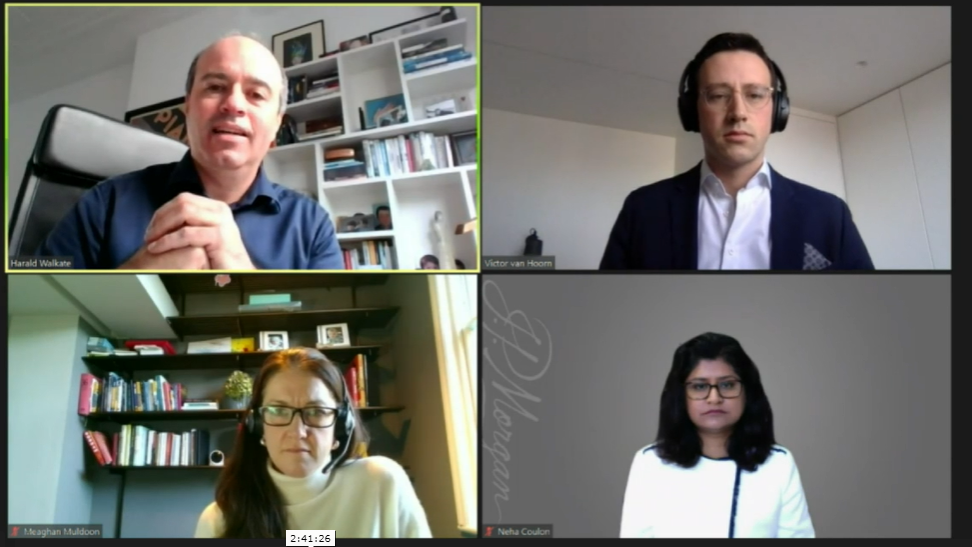The availability of ESG data has moved from “scarcity to abundance”, said asset manager representatives at a Reuters webinar last week, but this has led to a new set of challenges for the industry.
Speaking at the Reuters ESG Investment Europe Summit, for which ESG Clarity is media partner, on the panel entitled The ESG Data Goldrush: Achieve True Clarity When Assessing Opportunities, investment professionals said ESG data has come on leaps and bounds in recent years with new data providers being launched in response to demand.
However, the “move from scarcity to abundance of data doesn’t necessarily mean better information”, highlighted Meaghan Muldoon (pictured), global head of ESG integration at BlackRock.
Fellow panellist Neha Coulon, global head of ESG solutions at JP Morgan, agreed by saying: “The biggest challenge in ESG data is the abundance of it.”
Data journey
Outlining asset managers’ ESG data journey, Muldoon explained many firms have come from a starting point of working with third-party companies on portfolio and risk management to develop tools, such as stress testing and carbon offsetting.
Then asset management companies began to build internal resources and their own frameworks, bringing different data sets together. But more recently there have been new companies coming to the market offering ESG data from a different perspective – big data, AI and satellite mapping, for example.
Coulon added: “There has been a proliferation of start-up data providers that are coming up with new ways of processing data.
“However, there are some that are sophisticated and interesting, and some that are questionable.”

She also noted that while data has in most cases become more advanced it has become harder to drill down.
“Over the past four to five years, the focus has been on exclusion and risk rather than opportunity – that is where the data is lacking.
“Measuring ESG risk has become more sophisticated, but it is harder to identify opportunities,” she said.
Making up the trio of panellists, Harald Walkate, head of corporate social responsibility and responsible investment at Natixis Investment Managers, agreed that identifying what the data is assessing is extremely important as not understanding this could lead to inefficient use of the data.
“We are now moving to a place where data providers and users must be explicit on what they need to use the data for.
“It could be values alignment, risk management, financial performance, making a better world, or a combination of all of these.
“But if you are not sure what you want to achieve you will have a hard time getting there. It’s the responsibility of the data providers, but also the users to have these discussions to choose the objectives and have that clarity.”
ESG benchmarks – a necessary evil?
Chair of the panel Victor van Hoorn, executive director at The European Sustainable Investment and Finance Forum (Eurosif), highlighted there are “huge disparities” in ESG ratings and scores from different providers. While the panel said this is no bad thing, as “a difference of a opinion makes the market”, said Coulon, it also reinforces the need to be clear on what the data provider is measuring and the metrics you are focused on.
“’ESG ratings’ as a term can be quite misleading,” said Coulon, “as it implies it should be used like a credit rating and is regulated, transparent and has some level of synchronicity with the rest of the market.
“However, for ESG ratings, what we really have is scores or opinions.
“Different opinions of course make a market, but we typically don’t create benchmarks based on opinions.”
The panel said ESG ratings providers are creating their own benchmarks due to a lack of alternatives and demand from asset managers who want to demonstrate their ESG credentials to their clients.
“Historically, there has not been a lot of investment by ratings providers in ESG but now we have had this proliferation of rating frameworks come to the market,” Coulon continued. “It means the dialogue around ESG is getting richer, but I don’t think we should get too hung up on the correlations, or lack thereof.
“We are seeing these benchmarks being created but its causing confusion as it is based on opinion… I suppose it is a necessary evil.”
BlackRock’s Muldoon said some asset managers in the active space have realised these ESG benchmarks should not be taken at face value.
“The difference is there on purpose,” she said. “ESG ratings agencies have a point of view and when you buy data from them you are buying their point of view which is based on their scoring and underlying data.
“But what we are seeing in active management is an increased focus on that underlying data.”
Walkate reiterated that users of data providers and their benchmarks should not be concerned with the lack of correlation in the ratings and benchmarks, but more on “making sense of all the market information and how we can apply these to investment strategies,” which he said the team at active management firm Natixis are focused on.
“We must be clear on what we want to achieve – the correlation issue then isn’t such a problem and you can find the data you need to inform on that point.
“Investors need to carry out their due diligence on benchmark providers. They may be good at providing data on values alignment, which you are not interested in, but not good as risk management, which is your focus.
“This is something that active managers should all be used to doing.”
She added that although there is increased resources and commitments from companies to disclose on ESG, its still not enough for data to be completely reliable. and even the new alternative data set providers being included.








